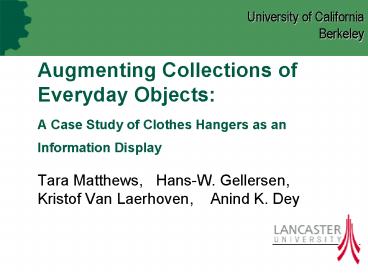Augmenting Collections of Everyday Objects: A Case Study of Clothes Hangers as an Information Displa - PowerPoint PPT Presentation
1 / 20
Title:
Augmenting Collections of Everyday Objects: A Case Study of Clothes Hangers as an Information Displa
Description:
Augmenting Collections of Everyday Objects: ... Benefits of everyday object collections as interfaces: ... Collections take advantage of spatial arrangement ... – PowerPoint PPT presentation
Number of Views:44
Avg rating:3.0/5.0
Title: Augmenting Collections of Everyday Objects: A Case Study of Clothes Hangers as an Information Displa
1
Augmenting Collections of Everyday ObjectsA
Case Study of Clothes Hangers as an Information
Display
University of CaliforniaBerkeley
- Tara Matthews, Hans-W. Gellersen, Kristof Van
Laerhoven, Anind K. Dey
2
Overview
- Introduction
- Hanger Display
- Evaluation
- Results
- Design Considerations
3
Introduction
- One goal of ubiquitous computing
- To support natural interaction technology
- One common solution
- Digitally augment everyday objects that have
well-established functions and meanings - Our project
- Explore how sets of everyday, physical artifacts
can collectivelyprovide an information display
or interactive behavior
4
Collections as Interfaces
- Distinction from previous work in collections
- Everyday artifacts are individually meaningful
entities to start with - Reasons to explore this approach
- Use of everyday context
- Collections take advantage of spatial arrangement
- Many collections naturally exist
5
Case Study The Hanger Display
- Designed and implemented a generic interface
consisting of a collection of augmented hangers
on a rod - Implemented three peripheral display applications
for the Hanger Display - Collected formative user feedback
6
The Hanger Display
?
7
The Hanger Display
- Each hanger has LED attached
- Hangers form a row of LEDs
- Lighting of LEDs can mean different things (many
possible inputs) - Three peripheral display inputs
- Temperature
- Barometric pressure
- Remote presence
8
Design Why Hangers?
- Common objects in the home, naturally formed into
collections - Hangers associated with
- hanging up and picking out clothes
- morning rituals
- getting ready for work or the day
- During these activities, people are interested in
easy access to related information - weather or their schedule to determine what to
wear - amount of email as an indication of how much work
there is to do - traffic to give an indication of commute time
9
Design Why Hangers?
- Affordances
- When hanger is hung on rod, it is part of the
application - Reduces the need for dedicated devices
- Hangers are already part of morning activity why
not make them more useful?
10
Challenges
- Preserve natural interaction
- Technology cannot interfere with everyday use of
hangers. - People will want to move, add, and remove
hangers. - Resiliency to change
- Everyday use should not interfere with the
technology (i.e., it should not break the
application).
11
Implementation
- Power and data supplied to LEDs via rod using
MicroLAN protocol - Java software on a laptop controls hanger LEDs
- Simple, cheap technology
- Resilient to change
12
Formative Evaluation
- In-lab, 8 participants
- Purpose
- Obtain feedback on the concept of everyday object
collections as interfaces - Method
- Showed three applications to demonstrate Hanger
Display - Informally interacted with display
- Interview qualitative feedback
- Brainstorm new applications and interaction
13
Results
- Realistic use for such displays all users
suggested applications they would use - Many suggestions involved more interaction,
something afforded by physical collections - Points to new, creative, and useful applications
of ubiquitous computing that support activities
in situ
14
Clothing Shop Example
15
Results
- Realistic use for such displays all users
suggested applications they would use - Many suggestions involved more interaction,
something afforded by physical collections - Points to new, creative, and useful applications
of ubiquitous computing that support activities
in situ
16
Design Considerations
- Existing structures can be useful in defining
interface scope - Interfaces composed of everyday artifacts must be
resilient to change - This type of physical interface could lead to new
interaction possibilities
17
Conclusion
- Explored how sets of everyday, physical artifacts
can collectively provide an information display
or interactive behavior - Benefits of everyday object collections as
interfaces - Everyday objects provide opportunities for useful
applications that support activities in situ - Collections take advantage of spatial arrangement
- Designed and implemented The Hanger Display as a
case study - Confirmed design considerations for such
interfaces
18
Questions or Comments?
- For more information
- http//www.eecs.berkeley.edu/tmatthew/
University of CaliforniaBerkeley
19
(No Transcript)
20
Red LED
Power and Data
Switch
Ground































